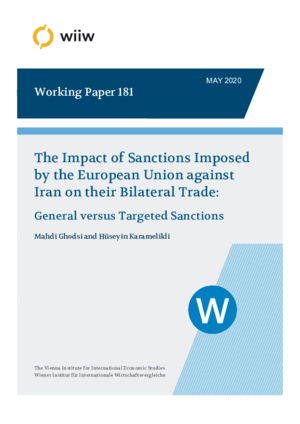The Impact of Sanctions Imposed by the European Union against Iran on their Bilateral Trade: General versus Targeted Sanctions
Mahdi Ghodsi and Hüseyin Karamelikli
wiiw Working Paper No. 181, May 2020
25 pages including 6 Tables and 5 Figures
Economic sanctions are intensively used by international institutions to enforce political objectives. Since 2006 the EU has been implementing general sanctions against the whole economy of Iran, affecting their trade relations. Since 2007, and following the imposition of sanctions by the UN Security Council, the EU has also implemented smart sanctions targeting Iranian entities and natural persons associated with its military activities. In a non-linear autoregressive distributed lag (NARDL), this paper investigates the impact of general and targeted EU sanctions against Iran on quarterly bilateral trade values between the 19 members of the euro area (EA19) and Iran between the first quarter of 1999 and the fourth quarter of 2018. The results indicate that general sanctions have strongly hampered trade flows between the two trading partners. The impact of general sanctions on the total imports of the EA19 from Iran is more than four times stronger than on the total exports of the EA19 to Iran. Moreover, the EU’s general sanctions have hampered trade in almost all sectors, except for the primary sectors. Furthermore, our study finds that the impact of smart sanctions targeting Iranian entities and natural persons is much smaller than the impact of general sanctions on total trade values and the trade values of many sectors. Smart sanctions affect the exports of most sectors from the EA19 to Iran, while they are statistically insignificant for the imports of many sectors from Iran. Thus, this paper provides evidence on the motivations behind smart sanctions, which target specific individuals and entities rather than the whole economy, unlike general sanctions, which have a negative impact on ordinary people.
Keywords: Smart sanctions, Iran, trade values, time series analysis, NARDL
JEL classification: F13, F14, F50, F51
Countries covered: European Union, Iran
Research Areas: International Trade, Competitiveness and FDI
